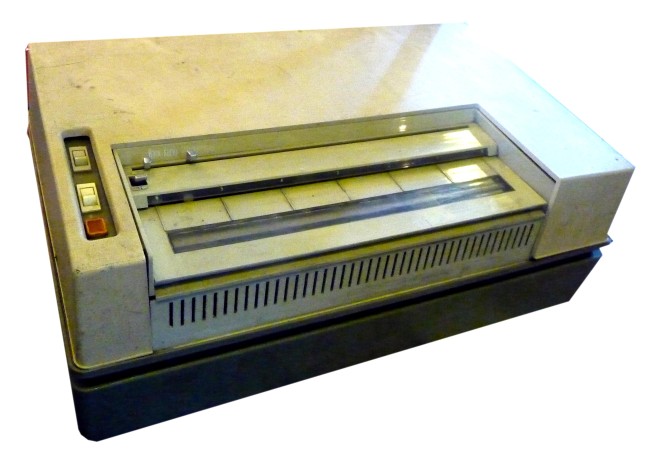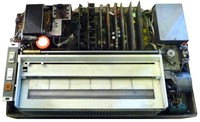Rank Xerox Telecopier 400 modified for development trials of a later U.K. version.
| Home > Browse Our Collection > Computers > Xerox > Rank Xerox Telecopier ... a later U.K. version. |
|
It finally saw the market, in much modified form, as the Telecopier 455. The plinth contained all the extra development hardware. With this lot switched off, the machine operated as a normal Telecopier 400. I expect that this will all have been removed, in your case, and that the plinth is empty. The Telecopiers 1, 2, 400 and 455 were all Group 1, analogue machines (ie. pre-digital and pre sub-one minute A4 transmission) Thoughthe TC455was marketed as a (pretend) Group 2 machine. The Telecopier 455 used the same mechanicals as the Telecopier 400, but the whole thing was rotated 90 degrees, anti-clockwise, on the desk top, and fitted with a completely different cover which disguised this fact. The downside of this was that the slot for inserting the media was now vertical (from back to front) and on the right hand side of the machine. It was very difficult for acute left handers to operate. Although it maintained the ability to communicate with all the earlier models in 1,200 to 2,100 Hz, frequency modulated (FM), at 4 minutes per A4, it now had the added ability to communicate with other Telecopier 455s using Amplitude Modulation (AM), with a sub 2 minute A4 speed. This mode was not compatible with earlier models, of any make. It was unique to this machine. It
accomplished this by a combination of tricks: The Components shown on the the internal photograph are as follows: In the rear-left is the very large (by today's standards) power supply, comprising the big, mains transformer, with voltage adjustment, smoothing capacitor, fuse and the two adjacent boards, PCBs 1& 2. These could all differ between markets. In rear-right is the Line Interface Assembly (the tin box). This, along with its two adjacent boards, PCBs 7 & 8, also varied between markets to suit the local PSTN regulations and line conditions.On UK machines this was designed by GPO Telephones and, essentially comprises a large 3000 type, telephone exchange relay which switches the machine to line when the orange button is pressed. For the US market this assembly is completely missing, being replaced by an 'acoustic coupler' which protrudes through the top of the case. This enabled the machine to be fully portable by inserting any telephone handset into the coupler. The other four boards are the Alarm Board, Transmit Board, Receive Board and Motor Control Board. Very few integrated circuits were used, the electronics being almost totally discreet. The Telecopier 455 generated few sales, as it and the older TC400s were rapidly replaced by the, fully digital,TC485, Group 2 and TC495 Group 3 machines. Our machine was kindly donated by Jeremy WilcoxWe are extremely grateful to Stuart Yearsly who has kindly furnished us with the correct description of the machine and the detailed explanation of the components. Stuart Yearsley was the UK's field Technical Specialist on this and other Xerox Fax. machines, for over eight years. He saw the UK's version, of the Telecopier 400, through from its pre-production prototypes to its demise and replacement. Manufacturer : Xerox This exhibit has a reference ID of CH6514. Please quote this reference ID in any communication with the Centre for Computing History. |
|











